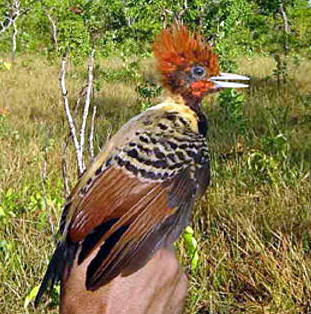Kaempfer's Woodpecker
From Wikipedia, the free encyclopedia
[Photo] Caatinga Woodpecker, Celeus obrieni. Author Guilherme R. C. Silva
Kaempfer's Woodpecker (Celeus obrieni) is a species of woodpecker from Brazil. The type specimen, a female, was collected in the Brazilian state of Piau?? in 1926. No other individuals were collected or seen and the bird was feared extinct, until a male was captured during mist netting in 2006 in the state of Tocantins. It was known as Caatinga Woodpecker for some time, but this name is misleading and based on confusion between 2 places with similar names.
Taxonomy
Normally, it has been considered a subspecies of the Rufous-headed Woodpecker (Celeus spectabilis), but an evaluation by the South American Classification Committee in 2003 resulted in it being recognized as a distinct species. This was based on the differences in habitat, size and plumage, combined with the large distance (more than 3000 kilometers [1850 mi]) between the ranges of the two species.
Desciption
It has a total length of about 24 centimeters (9½ in). The head and remiges are mainly rufous-chestnut, the underparts and back are buff, the wing-coverts are barred in black and buff and the chest and tail are uniform black. The male has a red malar and mottling on its crest. For comparison, the Rufous-headed Woodpecker is larger and has extensive black barring on the back and underparts.
Habitat
Little is known about its habitat preference, but it appears to be associated with bamboo (specifically Gadua paniculata) growing in Cerrado and babassu palm forest; very unlike the humid forest and woodland where the related Rufous-headed Woodpecker is found. There is no evidence to suggest that it occurs in Caatinga. Rather, the authors who proposed the name and association with caatinga habitat mistook a place in the caatinga called Uru??u??-Una for the type locality Uru??u??, some 180 km NNW in cerrado habitat.
This has led to Kaempfer's Woodpecker being suggested as a common name instead of Caatinga Woodpecker. The new name honours Emil Kaempfer who collected the type.
Status
Being recently rediscovered after 80 years without any records, it is highly endangered. Repeated visits to the site of the recent rediscovered has identified eight individuals with an additional four at a nearby site. The new site is threatened by the construction of a new section of the Bel??m-Bras??lia highway, and habitat loss is likely to be the main threat. However, due to the taxonomic confusion with the Rufous-headed Woodpecker, it has only recently been evaluated by BirdLife International where it has been given a status of Critically Endangered for the 2007 Red List.
http://en.wikipedia.org/wiki/Kaempfer%27s_Woodpecker
| The text in this page is based on the copyrighted Wikipedia article shown in above URL. It is used under the GNU Free Documentation License. You may redistribute it, verbatim or modified, providing that you comply with the terms of the GFDL. |
|

